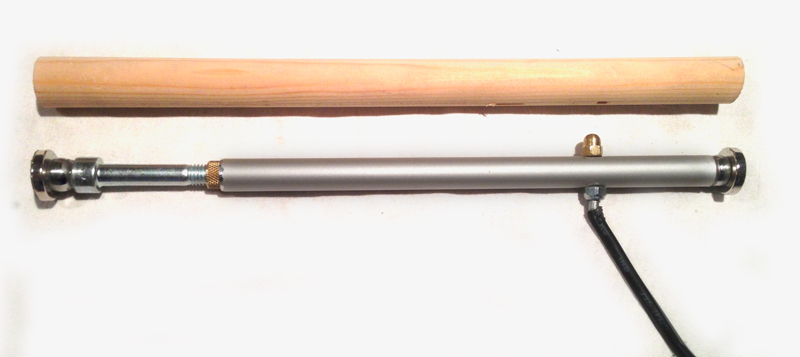If you need a new Soundpost for a double bass, you usually take the already existing Soundpost for reference, and make the new one slightly longer or shorter, whatever you need in particular. While the proper length is not that difficult to measure inside the bass, the correct angle of the Soundpost’s bottom and top flat sides are always hard to guess, and a matter of time consuming trial and error. Of course, you can get the angle from the outside of the top and the back, but it’s difficult to find the exact position and the plates themselves aren’t always parallel, so the outsides only give you a rough idea of the angles.
I had some time during the Christmas holidays, so I’ve built my own measuring tool which will hopefully save me some time in future. The shaft is a aluminum tube of 10 mm diameter. On one end, I glued on a steel ball with epoxy. On the other side, I inserted a brass thread and a screw (M8) for length adjustment, again with a steel ball glued on.
Then, I put magnet rings on both steel balls. The power of magnetism holds them firmly on the balls, but will allow the to follow the curvature and angle of back and top smoothly – that’s the key idea of this device. With some sandpaper, I’ve dulled the balls’ surface, in order to prevent the magnets from moving too easily. I now set the device to the guessed length of the upcoming soundpost, set it into position inside the bass and re-adjust the length if needed. The magnets are much slippier than soundpost wood is, so I glued on fine sandpaper. Once the device has the proper length at the correct position, I remove the device carefully (so that the magnets stay in their position). For inserting and extracting the device, I use a fixed bent wire instead of the S-shaped soundpost setter tool – but this still needs some improvement. Besides this, it’s pretty cool. Transfering the angles to the soundpost is still a little tricky, but much better than guesswork.



Why wouldn’t it work as the actual soundpost? I’ve seen info about a carbon fiber adjustable post, but it seems in many cases (especially on less-expensive basses) a simple, adjustable aluminum post would be perfect!
I think that a bare aluminium made soundpost may be too reverberant, eg it will show the resonances determined by the length.
A wooden post has some degree of internal damping, of course dependent on the type and hardness of the wood. This supresses ressonance problems somewhat.
So if you want to try with an aluminium post be prepared to add some damping material ???